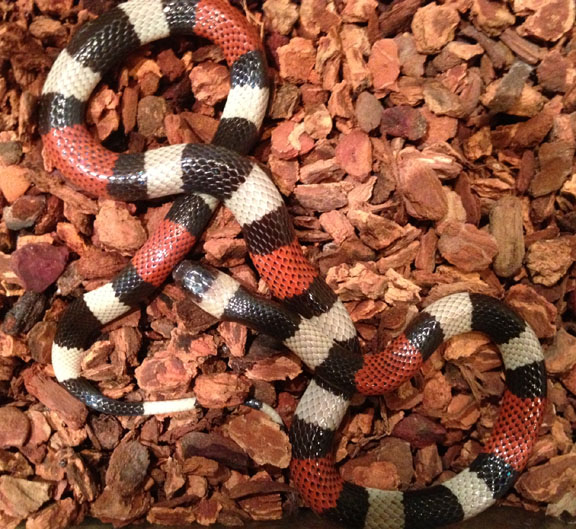 photo by kingsnake.com user MXHerper of a coral snake Micrurus laticollaris
photo by kingsnake.com user MXHerper of a coral snake Micrurus laticollaris
We all know the rhyme, the one that has caused consternation to many an experienced herper but is just so catchy it sticks around. Red touch yellow, kill a fellow, red touch black, venom lack. Variations occur, but all of them are equally flawed. Plenty of highly venomous coral snakes across the western hemisphere fail to pay heed to that little saying, how rude.
I get the reason for the rhyme. In most of the US, the most commonly encountered tricolors do adhere to it. One may discern a harmless milk or kingsnake from a venomous coral snake by the pattern of colors...among a host of other features of course.
So why would a harmless snake look like a dangerously venomous snake? Mimicry. Let's explore this for a bit. In ecology, mimicry is generally classified into two major groups: Batesian or Mullerian. Batesian is when a harmless species looks like a dangerous species, and Mullerian is when two dangerous species look similar to each other.
Here's where the misconception comes in. Most of the time, we say a milk snake is "trying to look like" a coral snake, or a hognose snake is "trying to look like" a cobra. Think about that for just a second. Milk snakes
know nothing about coral snakes. Hognose snakes certainly know nothing about cobras. The problem is in the phrasing. Mimicry is an amazing biological process that deserves so much more nuance and explanation than a Lamarckian sort of misconception like one species "wants" to look like another.
Instead, let's actually be willing to delve into the convergence between two groups of organisms. Bright coloration, aka aposematic coloration, is ubiquitous in nature. Often used as a warning, like "eat me, and it might be the last thing you do," this is obviously an effective survival strategy that's been adopted by a ton of critters. Brightly colored bands on milk snakes and coral snakes both serve the same purpose: warning, justified or not, to dissuade predation. Mimicry is simply convergent evolution - groups of organisms stumbling upon similar survival characteristics. Bright colors like with the milk and coral, making yourself look larger like with the hognose and cobra, shaking a tail like with rat snakes and rattlesnakes - all are characteristics or behaviors that increase an organism's odds of living long enough to reproduce - and that, ladies and gentlemen, is the name of the game.
So next time you're discussing mimicry, give yourself and your audience the time and patience to delve into the nuance, and try not to fall back on easier phrases that perpetuate misconceptions.


